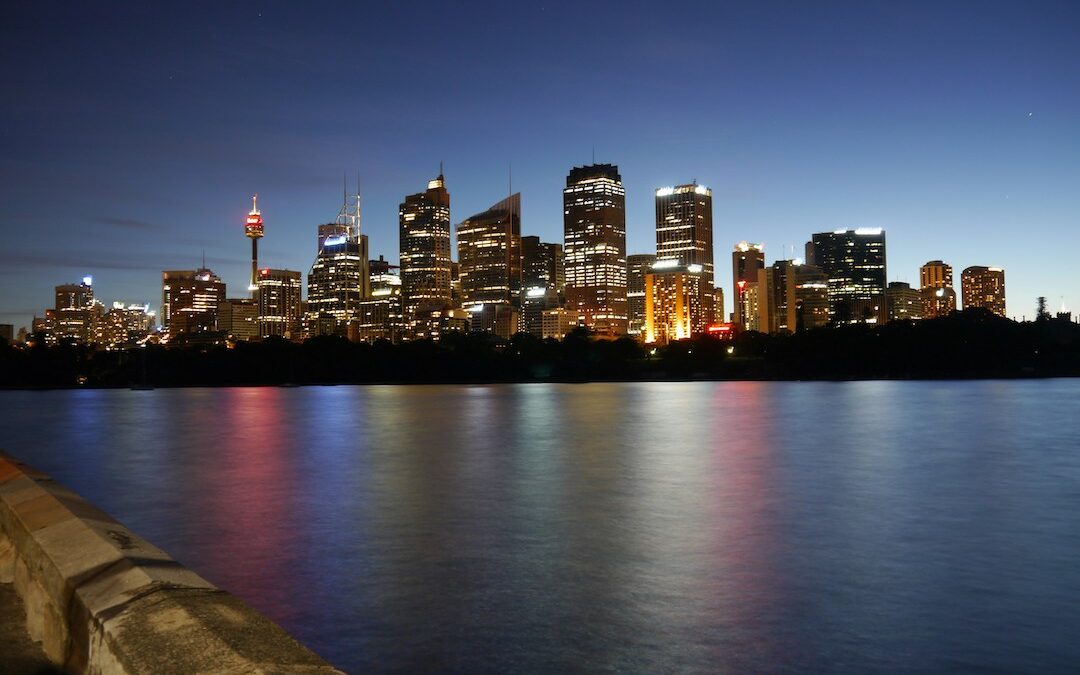As 24 new infrastructure projects are scheduled for 2025, light pollution from Sydney remains a significant issue.
Light pollution affects more than 80 per cent of the world’s population due to excessive use of artificial light sources at night – and Sydney is no exception. While most of Australia’s outback stays dark, the major cities on the east and west coasts remain starkly illuminated, as seen on The Light Pollution Map.
Opening Image: Light pollution from Sydney / Anna Tremewan Unsplash
Types of light pollution
The three main types of light pollution – glare, clutter and light trespass – contribute to sky glow, the light pollution from large urban cities. Glare exists when uncontrolled light exceeds what your eyes can handle, such as a passing car’s headlights at night. Clutter occurs when large amounts of light group together in one area, such as a city’s downtown. Light trespass happens when light extends into unwanted areas, such as a street lamp shining through a bedroom window.
These different types of light affect humans, nature and the environment in various ways resulting in unusual patterns of behaviour due to the unnatural cycles of light and our bodies’ inability to regulate it.

Bird perched on a branch at night showing glow behind it like light pollution from Sydney / Patrick Hendry Unsplash
Who’s responsible?
Bad light fixtures and design cause excess illumination to escape a controlled area and into the sky. These fixtures can include Sydney’s large amount of decorative, street and landscape lighting.
With the competing interests of upscale nightlife and environmental safety, The City of Sydney Exterior Lighting Strategy states its objectives are to ensure all lighting on new infrastructure complies with the two Australian standards and requires approval through the National Association of Testing Authorities. This will help to reduce environmental damage while maintaining safety and fun.
But does this include old lighting fixtures?
Some fixtures in Sydney received upgrades like the Ausgrid Smart Street Lighting Upgrade Program change in 2023, but many still need design help. Shielded motion-sensor lighting fixtures are the most environmentally friendly alternatives for street and city lighting because they direct light toward the ground for safety and save electricity by paying for only what you need.

Examples of best light practices in commercial fixtures and the differences they make to the light pollution from Sydney / Getty Images
Impacts on Sydney wildlife
Sydney houses diverse animal species and some rely heavily on their nocturnal cycles for basic function. Bright light severely affects birds, bats and insects in Sydney by disorienting their migration patterns, affecting food supply, disturbing sleep and reducing survival instincts as animals and birds use the stars to navigate.
In a study conducted by Scientific Reports, small mammal activity decreases 40-75 per cent on bright moonlit nights, directly translating to a lack of activity in artificially lit areas. These bright areas also greatly interrupt the birth of baby wallabies in Australia because of missed food hunting hours, resulting in mothers abandoning their young, according to a Royal Society study.
The impact of light pollution on the everyday lives of both animals and people is typically less discussed. Humans need light for work, safety and nighttime activities – but how can we use it safely?

Pelican sits in a harbour illuminated by city glow like the light pollution from Sydney / David Clod Unsplash
Solutions
Taking measurements of light in Palm Beach Headland, Australia’s first new Urban Night Sky Place, Professor of Astrophysics at Macquarie University, Professor Richard McDermid, sees the subtle effect with large impact.
“Light diffuses very broadly. That makes it difficult to manage from a legislation or planning control perspective, because you’ve crossed so many boundaries and private land,” Professor McDermid said.
But the effects can be reversed through simple actions. The best light practices that aided Palm Beach Headland were only adding light in needed areas, adaptive light controls for colour and timing, covered lights that aim at the ground and avoiding bright white light.
“Growing up in the west of Scotland, being exposed to a dark night sky got me curious about the big questions of the universe and the value of a pristine night sky is something that they can now be proud of as part of their environment and enjoy,” Professor McDermid said.
These best light practices can be implemented into light design in Sydney to ensure a safe and beautiful sky in the future.
To find dark night sky stars check out our TrulyAus 8 stellar spots to stargaze in and around Sydney here!

